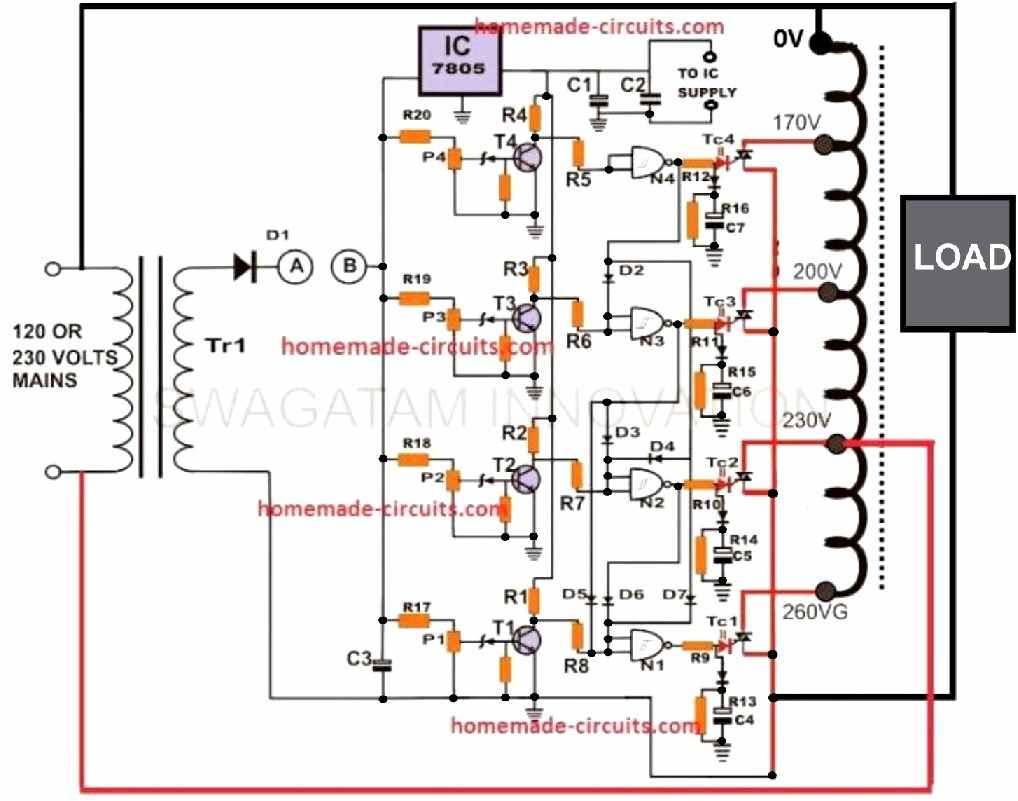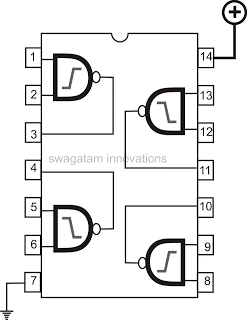In this article I have explained a relatively simple triac controlled automatic mains voltage stabilizer circuit, which uses logic ICs and a few triacs for controlling the mains voltage levels.
Why Solid State
Being solid state in design, the voltage switching transitions are very smooth with minimum wear and tear, resulting in efficient voltage stabilization.
Discover the whole construction procedure of this unique, solid state mains voltage stabilizer.
The proposed circuit of a triac controlled AC voltage stabilizer will provide an excellent 4 step voltage stabilization to any appliance at its output.
With no moving parts involved its efficiency is further enhanced. Find out more of this silent operator: power guard.
The circuit of an automatic voltage stabilizer discussed in one of my previous articles, though useful, due to its simpler design, does not have the capability of controlling the different levels of varying mains voltages discretely.
The proposed idea though not tested, looks pretty convincing, and if the critical components are properly dimensioned, should work as expected.
The present circuit of triac controlled AC voltage stabilizer is outstanding in its performance and is almost an ideal voltage stabilizer in every respect.
As usual the circuit has been exclusively designed by me. It is able to control and dimension the input AC mains voltage accurately through 4 independent steps.
The use of triacs make it sure that the changeovers are quick (within 2 mS) and with no sparks or transients usually associated with relay type of stabilizers.
Also since no moving parts are employed, the entire unit becomes completely solid state and almost permanent.
Let’s proceed to see how the circuit functions.
CAUTION:
EACH AND EVERY POINT OF THE CIRCUIT PRESENTED HERE MAY BE AT AC MAINS POTENTIAL, THEREFORE EXTREMELY DANGEROUS TO TOUCH IN SWITCHED ON POSITION. UTMOST CARE AND CAUTION IS ADVISED, USE OF A WOODEN PLANCK UNDER YOUR FEET IS STRICTLY RECOMMENDED WHILE WORKING WITH THIS DESIGN .... NEWBIES PLEASE KEEP AWAY.
Circuit Operation
The functioning of the circuit may be understood through the following points:
Transistors T1 to T4 are all arranged to sense the gradual rise in the input voltage and conduct one after the other in sequence as the voltage rises and vice versa.
Gates N1 to N4 from IC 4093 are configured as buffers. The outputs from the transistors are fed to the inputs of these gates.

All the gates are interconnected to each other in such away that the output of only a particular gate remains active at a given period of time according to the level of the input voltage.
Thus, as the input voltage rises the gates respond to the transistors and their outputs subsequently become logic hi one after the other making sure that the previous gate’s output is shut OFF and vice versa.
The logic hi from the particular buffer is applied to the gate of the respective SCR which conducts and connects the relevant “hot” line from the transformer to the external connected appliance.
As the voltage rises, the relevant triacs subsequently select the appropriate “hot” ends of the transformer to increase or decrease the voltage and maintain a relatively stabilized output.
How to Assemble the Circuit
The construction of this triac control AC power guard circuit is simple and just a matter of procuring the required parts and assembling them correctly over a general PCB.
It is pretty obvious that the person who is attempting to make this circuit knows a bit more than just the basics of electronics.
Things may go drastically wrong if there is any error in the final assembly.
You will require an external variable (0 to 12 volts) universal DC power supply for setting up the unit in the following way:
Assuming that an output supply of 12 volts from TR1 corresponds to 225 volts input supply, through calculations we find that it will produce 9 volts at an input of 170 volts, 13 volts will correspond to 245 volts and 14 volts will be equivalent to an input of approximately 260 volts.
How to Set Up and Test the Circuit
Initially keep the points “AB” disconnected and make sure the circuit is totally disconnected from the AC mains.
Adjust the external universal power supply to 12 volts and connect its positive to the point “B” and negative to the common ground of the circuit.
Now adjust P2 until LD2 is just switched ON. Reduce the voltage to 9 and adjust P1 to switch ON LD1.
Similarly, adjust P3 and P4 to illuminate the relevant LEDs at voltages 13 and 14 respectively.
The setting procedure is now complete. Remove the external supply and join points “AB” together.
The whole unit may now be connected to the mains AC so that it can start working right away.
You may verify the performance of the system by supplying a varying input AC through an auto transformer and checking the output using a digital multimeter.
This triac controlled AC voltage stabilizer will shut OFF at voltages below 170 and above 300 volts.
IC 4093 Internal Gate Pinout Arrangement

Parts List
You will require the following parts for the construction of this SCR control ac voltage stabilizer:
All resistors are ¼ Watt, CFR 5%, unless otherwise stated.
- R5, R6, R7, R8 = 1M ¼ watt,
- All Triacs are 400 volts, 1KV rated,
- T1, T2, T3, T4 = BC 547,
- All zener diodes are = 3 volts 400 mW,
- All Diodes are = 1N4007,
- All presets = 10K linear,
- R1, 2, 3, 4, 9, 10, 11, 12, 13, 14, 15, 16, 17, 18, 19, 20 = 1K ¼ watt,
- N1 to N4 = IC 4093,
- C1 and C3 = 100Uf/ 25 volts,
- C2 = 104, ceramic,
- Power Guard Stabilizer Transformer = “Made to order” having 170, 225, 240, 260 volts output Taps at 225 volts input supply, or 85, 115, 120, 130 volts taps at 110 AC input supply.
- TR1 = Step down transformer, 0 – 12 volts, 100 mA.